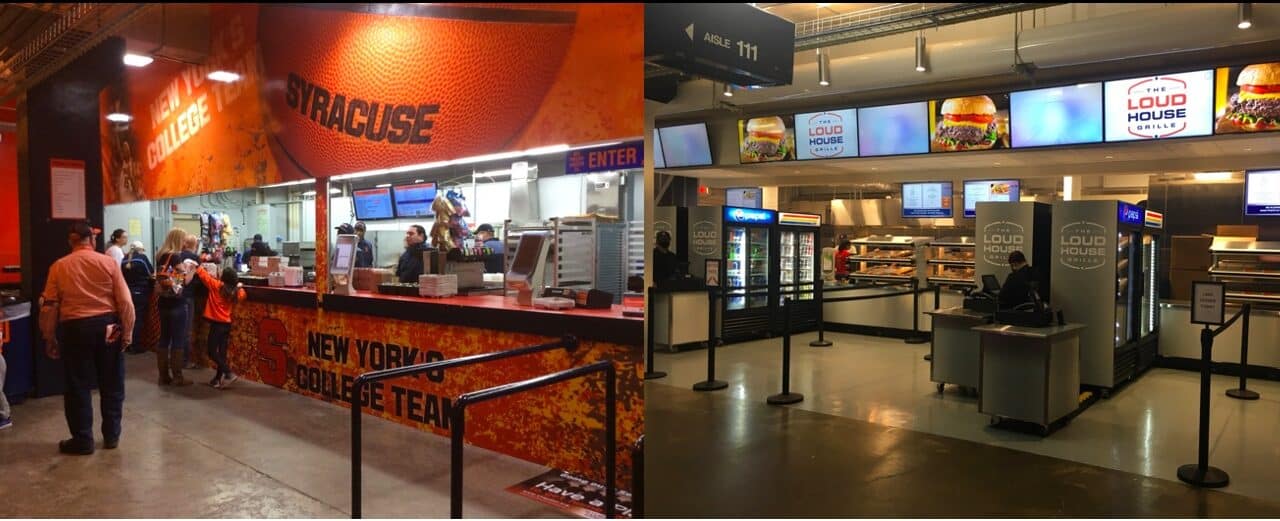BEFORE AND AFTER: Part of the initial renovations at Syracuse’s JMA Wireless Dome included converting eight traditional concessions stands to the grab-and-go market format.
CLIPPERS AND CONCESSIONS
Michael Bekolay’s food consulting business is picking up steam as the 35-year industry veteran competes against Chris Bigelow, Mike Plutino, Paul Frascella and JHSports+, among others, to advise teams and venues on things they can do to better serve their patrons.
Some of Bekoway’s work revolves around starting from the ground up at shiny new facilities. Bekolay, founder and CEO of Venue Hospitality Solutions in Weston, Florida, served in executive roles with Centerplate, Boston Culinary Group and Legends, where he ran the food at AT&T Stadium, before starting his own consultancy in March 2019. He’s working with the Buffalo Bills as they go through the process of selecting a concessionaire for their new $1.4 billion NFL stadium, targeted to open in 2026. Bekolay has been advising the Bills since late December on the design of general concessions and premium dining after the team issued an RFP for food service last summer.
Delaware North Sportservice, which is headquartered in Buffalo, has been the Bills’ food provider since 1998.
In Las Vegas, Nevada, Bekolay is consulting for the Las Vegas Convention Center to evaluate how the food operation can be improved at one of the country’s biggest
convention facilities with 2.5 million square feet of exhibit space. Sodexo Live is the concessionaire in Vegas.
At Syracuse University, Venue Hospitality Solutions teamed with the ACC school to help improve concessions at the JMA Wireless Dome, formerly the Carrier Dome, home of Orangemen football and men’s basketball. The 43-year-old building has gone through more than $160 million in renovations over the past five years.
Syracuse runs the food in-house. Food service was part of the initial phase of upgrades completed a few years ago. Eight traditional belly-up concession stands, equally distributed among the lower and upper concourses, were converted to a setup similar to the grab-and-go format that’s been a hot trend of late.
The new layout has been profitable to the point that Syracuse officials want to retrofit all concession stands in that manner, Bekolay said.
The difference is they’re not strictly designed as a marketplace with frictionless technology tied to Amazon or Zippin with camera scans overhead, he said. Instead, the front counters were eliminated and reconfigured with four designated lanes to pick up hot foods laid out in front of the grill and cold drinks out of coolers before going to self-checkout.
“The lift (in sales) has been unbelievable,” Bekolay said. “The best way to put it is we imagined the process from the guest experience going back into the space versus the approach an operator might have from the back wall into the concourse. It was quite risky going exclusively to this format. (The strategy) was ‘let’s solve the issue of getting a lot of the core menu items into people’s hands and get them out watching the game.’”
It’s not all or nothing, though, in terms of going exclusively with one setup over the other. Bekolay feels there can be a mix of traditional and grab-and-go stands, especially for older venues where space is at a premium as operators address the age-old issue of long lines and speed of service.
“When you think about the traditional 40 by 20 square feet that concessionaires have had to operate in at older facilities, this is a revolutionary approach to it that gains back concourse space and improves the guest experience,” Bekolay said. “It took a great deal of thought before they embarked on it. We paused on re-doing more stands due to the pandemic, but there’s a huge appetite to push forward as their business opens up again.”

VenuesNow Senior Editor Don Muret
INTUITION: During a trip to attend the Stadium Managers Association seminar in mid-February, VenuesNow took a hardhat tour of the Intuit Dome, the Los Angeles Clippers’ new arena taking shape down the street from SoFi Stadium and the Kia Forum.
The $2 billion project is a little more than halfway built for a 17,700-seat arena opening for the 2024-25 NBA season.
First impressions: Clippers owner Steve Ballmer wants the most intimidating game day experience in sports and it looks like he got his wish from standing at the top of the building looking down on the seating bowl. Very steep, especially “The Wall,” the supporters section spanning 51 rows of about 5,000 seats without a break, behind the east basket, conveniently adjacent to the visitor’s bench.
The arena, designed by AECOM, is basketball-specific. As a result, there is no ice floor, which helps make the bowl a little more intimate without having to plan for an additional 30 to 40 feet for that surface, project officials said. The Intuit Dome can still book Feld Entertainment’s Disney on Ice productions because Feld travels with its own system to form a temporary ice surface for those who need it, officials said.
The arena does have plenty of basketball courts, five in fact: the game court, two courts in the Clippers’ practice facility attached to the arena, an outdoor court on the outdoor plaza and a “promotional” court off the main concourse. The promo court is designed for youth and high school basketball, corporate events and holiday parties. It has a separate entrance with its own locker rooms, videoboard and bench seating for 400 people.
EDITOR’S NOTE: Senior Editor Don Muret’s column appears monthly in VenuesNow magazine. It’s been updated to run in Pulse.







